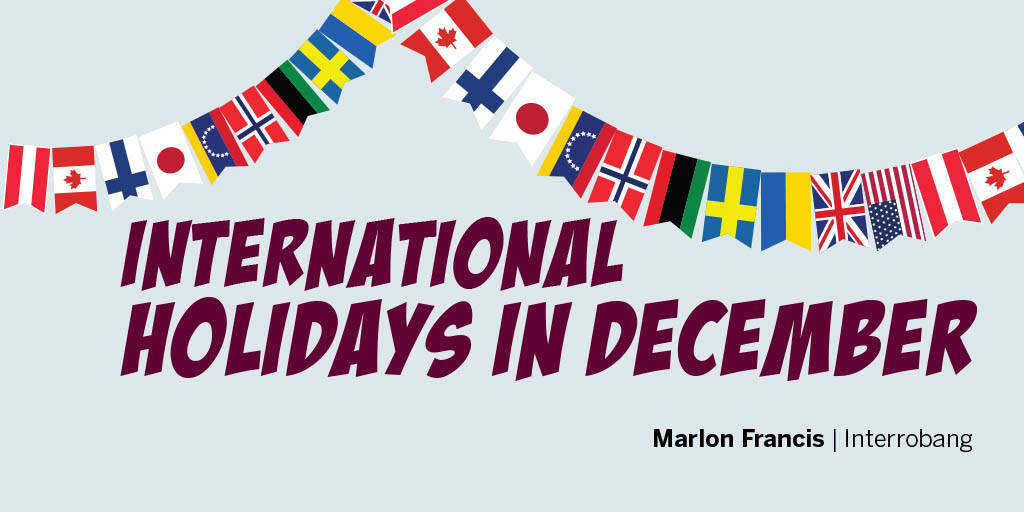International Holidays in December

December is a month of cold, snow, and most importantly, holidays. Out come the decorations, the calls to friends and family to arrange visits, and of course presents and food. December has many holidays and festivals, like Christmas, that are celebrated by different cultures throughout the world. Below we identify a few of them and look a little deeper at their origins and traditions.
St. Lucia Day (Sweden)
The lore of this holiday follows a young Christian woman who was martyred and killed for her faith in early 2nd century Sweden. She would secretly smuggle food into the catacombs of Rome for the persecuted citizens of the city. She would wear candles on her head to illuminate her way, a custom that is carried forward in today’s traditions.
The celebrations see young girls adorning a similar crown of candles on their head, wearing long white dresses and red sashes as they begin the morning of St. Lucia Day by singing and bringing coffee and saffron buns called ‘Lucia Cats’ to their parents for breakfast. This holiday is celebrated on December 13, and is observed in Denmark, Norway, Finland, Bosnia and Croatia, to name a few.
Hanukkah (Judaism)
This holiday commemorates the re-dedication of the holy temple in Jerusalem following the victory of the Jewish rebel army (Maccabees) over a tyrannical king in 165 BCE. Its celebrations begin on the 25th day of the Jewish month of Kislev, which is roughly around late November, early December.
Because this holiday is based on a lunar calender, every year the beginning of Hanukkah has a different start date. The celebrations last for eight days, commemorating the eight-day miracle of Hanukkah. Oil used to light the menorah inside of the temple, for the re-dedication of the temple, was limited and suspected of only being enough for a day’s use. Miraculously, the Maccabees were able to maintain the torch of the menorah for eight days, and thus the Hanukkah miracle was born. Some of the traditions of this holiday include the lighting of the menorah, the spinning of the dreidel and the consumption of fried foods like latkes and jellyfried donuts called Sufganiyot.
Kwanzaa
(African American and Pan-African) Created in the ’60s by a black nationalist, Kwanzaa celebrates the African heritage in African-American and Pan-African culture. Kwanzaa lasts seven days running from December 26 to January 1. A holiday feast and gift-giving occur on the final day of the holiday week.
The holiday celebrates the seven principles of African heritage in an attempt to reconnect African descendants to their African culture. One of each of the seven principles is celebrated correspondingly to each day of the holiday. The different principles are unity, self-determination, collective work and responsibility, purpose, cooperative economics, creativity and faith.
Omisoka (Japan)
Celebrated on December 31, Omisoka consists of actions that help to rid individuals and families of things they don’t want to carry over into the New Year. The repayment of debts, house cleaning, the driving of evil spirits and bad luck from their homes, as well as bathing in the final hours of the day, are all activities done on Omisoka. People also celebrate at parties with friends and families, and often partake in viewing a four-hour television show called “Red/White Singing Battle Show”.
At midnight many families attend a temple to witness the ringing of a Buddhist bell that is struck 108 times to signify each of the 108 earthly temptations believed to cause human suffering. This is done to rid us of the temptations of the passing year, cleaning the slate, and allowing us to enter the New Year on a fresh note. Another tradition of the holiday is to stay awake all night to await the onset of the first sunrise of the New Year.
Bodhi Day (Buddhism)
Celebrated on December 8, this holiday reflects upon the period when the Buddha sat underneath the Bodhi tree and attained enlightenment. Followers are encouraged to reflect upon Buddhist principles, realigning themselves with the journey of enlightenment, and broadening their appreciation for the world at large and how their religion works within the modern world. It is celebrated by hanging connected coloured lights throughout their homes, representing the many different paths to enlightenment that there are.
The lights are hung for 30 days beginning on December 8. People also display a ficus tree in their homes, similar to the Christmas tree, and decorate it with three coloured ornaments that represent the Buddha, the dharma and the sangha, also referred to as the three jewels. A traditional meal of milk and rice can also be indulged in as a reminder of the first meal that the Buddha ate after his eight days under the Bodhi tree.















